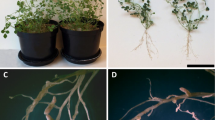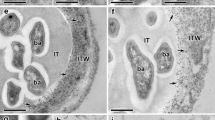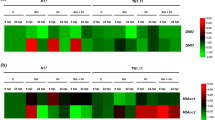Abstract
The ability of Phoma medicaginis to infect legume nodules and the subsequent effect on their functioning was investigated in Medicago truncatula lines, TN.8.20 and Jemalong6, inoculated with an efficient Sinorhizobium meliloti strain. Colonization of nodules by P. medicaginis strain Pm8 was confirmed by morphological and molecular analyses. P. medicaginis effect was more relevant on the most susceptible line, TN.8.20, where it decreased the nitrogen fixation capacity (NFC) significantly in nodules from 62 days after sowing (das) till the end of nodule life cycle; however in Jemalong6 nodules, the NFC inhibition was significant only at the flowering stage. Analyses of stress indices as structure, lipid peroxidation and leghemoglobin content did not show significant structural or metabolic alterations in infected nodules. Superoxide dismutase (SOD) activity was increased in nodules of both M. truncatula lines up to 62 das. After 78 das, increase of SOD activity continued only in Jemalong6 nodules. Changes in peroxidase (POX) activity were correlated to those revealed on NFC. Indeed, POX was decreased in nodules of TN.8.20 line but remained almost unchanged in Jemalong6. These results, suggest that POX represents a strong component of the defence mechanisms in nodules of resistant M. truncatula lines, where it could be involved in reinforcing the cell wall barrier. The stimulation of SOD activity is also a key mechanism in maintaining nodule integrity via controlling ROS overproduction when counteracting fungal attacks.


Similar content being viewed by others
Abbreviations
- ARA:
-
acetylene reduction activity
- das:
-
days after sowing
- Lghb:
-
Leghemoglobin
- MDA:
-
malondialdehyde
- NFC:
-
nitrogen fixing capacity
- ROS:
-
Reactive oxygen species
References
Agrios, G. N. (2004). Plant pathology (5th ed.). San Diego: Elsevier Academic Press.
Almagro, L., Gomez Ros, L. V., Belchi-Navarro, S., Bru, R., Ros Barcelo, A., & Pedreno, M. A. (2009). Class III peroxidases in plant defence reactions. Journal of Experimental Botany, 60, 377–390.
Antoun, H., & Prévost, D. (2005). Ecology of plant growth promoting rhizobacteria. In Z. A. Siddiqui (Ed.), PGPR: biocontrol and biofertilization (pp. 1–38). Netherlands: Springer.
Barbetti, J. M. (1995). Resistance in annual Medicago species to Phoma medicaginis and Leptosphaerulina trifolii under field conditions. Australian Journal of Experimental Agriculture, 35, 209–214.
Barna, B., Fodor, J., Harrach, B. D., Pogány, M., & Király, Z. (2012). The Janus face of reactive oxygen species in resistance and susceptibility of plants to necrotrophic and biotrophic pathogens. Plant Physiology and Biochemistry, 59, 37–43.
Beauchamp, C., & Fridovich, I. (1971). Superoxide dismutase, improved assays and an assay applicable to acrylamide gels. Analytical Biochemistry, 44, 276–287.
Ben Slimène, I., Tabbene, O., Djebali, N., Cosette, P., Schmitter, J. M., Jouene, T., Urdaci, M. C., & Limam, F. (2012). Putative use of Bacillus subtilis L194 strain for biocontrol of Phoma medicaginis in Medicago truncatula seedlings. Research in Microbiology, 163, 388–397.
Bolwell, G. P., & Daudi, A. (2009). Reactive oxygen species in plant–pathogen interactions. In L. A. del Río & A. Puppo (Eds.), Reactive oxygen species in plant signaling, (signaling and communication in plants) (pp. 113–133). Berlin: Springer.
Bradford, M. M. (1976). A rapid and sensitive method for the quantification of microgram quantities of proteins utilizing thenprincipal of protein-dye binding. Analytical Biochemistry, 72, 248–254.
Chihaoui, S. A., Mhadhbi, H., & Mhamdi, R. (2012). The antibiosis of nodule-endophytic agrobacteria and its potential effect on nodule functioning of Phaseolus vulgaris. Archives of Microbiology, 194, 1013–1021.
De Gara, L., De Pinto, M. C., & Tommasi, F. (2003). The antioxidant system vis-a’-vis reactive oxygen species during plant-pathogen interaction. Plant Physiology and Biochemistry, 41, 863–870.
De Gruyter, J., Aveskamp, M. M., Woudenberg, H. C. J., Verkley, G. J. M., Johannes, Z., Groenewald, J. Z., & Crous, P. W. (2009). Molecular phylogeny of Phoma and allied anamorph genera: towards a reclassifi cation of the Phoma complex. Mycological Research, 113, 508–519.
Deng, Z. S., Zhao, L. F., Kong, Z. Y., Yang, W. Q., Lindström, K., Wang, E. T., & Wei, G. H. (2011). Diversity of endophytic bacteria within nodules of the Sphaerophysa salsula in different regions of Loess Plateau in China. FEMS Microbiology Ecology, 76, 463–475.
Dhingra, O. D., & Sinclair, J. B. (1995). Basic plant pathology methods. London: CRC Press.
Djébali, N. (2013). Aggressiveness and host range of Phoma medicaginis isolated from Medicago species growing in Tunisia. Phytopathologia Mediterranea, 52, 3–15.
Djébali, N., Mhadhbi, H., Jacquet, C., Huguet, T., & Aouani, M. E. (2007). Involvement of hydrogen peroxide, peroxidase and superoxide dismutase in response of Medicago truncatula lines differing in susceptibility to Phoma medicaginis infection. Journal of Phytopathology, 155, 633–640.
Djébali, N., Mhadhbi, H., Lafitte, C., Dumas, B., Esquerré-Tugayé, M. T., Aouani, M. E., & Jacquet, C. (2011). Hydrogen peroxide scavenging mechanisms are components of Medicago truncatula partial resistance to Aphanomyces euteiches. European Journal of Plant Pathology, 131, 559–571.
Drabkin, D. L., & Austin, J. H. (1935). Spectrophotometric studies. II. Preparations from washed blood cells; nitric oxide hemoglobin and sulfhemoglobin. Journal of Biological Chemistry, 112, 51.
Ellwood, S. R., Kamphuis, L. G., & Oliver, R. P. (2006). Identification of sources of resistance to Phoma medicaginis isolates in Medicago truncatula SARDI core collection accessions, and a multigene differenciation of isolates. Phytopathology, 96, 1330–1336.
Govrin, E. M., & Levine, A. (2000). The hypersensitive response facilitates plant infection by the necrotrophic pathogen Botrytis cinerea. Current Biology, 10, 751–757.
Graham, J. H., Frosheiser, F. I., Stuteville, D. L., & Erwin, D. C. (1979). A compendium of alfalfa diseases. St Paul: American Phytopathological Society.
Hardy, R. W. F., Holston, R. D., Jackson, E. K., & Burns, R. C. (1968). The acetylene-ethylene assay for nitrogen fixation: laboratory and field evaluation. Plant Physiology, 43, 1185–1208.
Herridge, D. F., Peoples, M. B., & Boddey, R. M. (2008). Marschner review: global inputs of biological nitrogen fixation in agricultural systems. Plant and Soil, 311, 1–18.
Ko, K. S., & Jung, H. S. (2002). Three nonorthologous ITS1 types are present in a polypore fungus Trichoderma abietinum. Molecular Phylogenetics and Evolution, 23, 112–122.
Lamb, C., & Dixon, R. A. (1997). The oxidative burst in plant disease resistance. Annual Review of Plant Physiology and Plant Molecular Biology, 48, 251–275.
Lukezic, F. I., Leath, K. T., & Levine, R. G. (1983). Pseudomonas viridiflava associated with root and crown rot of alfalfa and wilt of birdsfoot trefoil. Plant Disease, 67, 808–811.
Macarisin, D., Cohen, L., Eick, A., Rafael, G., Belausov, E., Wisniewski, M., & Droby, S. (2007). Penicillium digitatum suppresses production of hydrogen peroxide in host tissue during infection of citrus fruit. Phytopathology, 97, 1491–1500.
Matamoros, M. A., Dalton, D. A., Ramos, J., Clemente, M. R., Rubio, M. C., & Becana, M. (2003). Biochemistry and molecular biology of antioxidants in the rhizobia-legume symbiosis. Plant Physiology, 133, 449–509.
Mellersh, D., Foulds, I., Higgins, V., & Heath, M. (2002). H2O2 plays different roles in determining penetration in three diverse plant-fungal interactions. Plant Journal, 29, 257–268.
Mhadhbi, H., Jebara, M., Limam, F., Huguet, T., & Aouani, M. E. (2005). Interaction between Medicago truncatula lines and Sinorhizobium meliloti strains for symbiotic efficiency and nodule antioxidant activities. Physiology Plant Journal, 124, 4–11.
Mhadhbi, H., Fotopoulos, V., Djebali, N., Polidoros, A. N., & Aouani, M. E. (2009a). Behaviours of Medicago truncatula-Sinorhizobium meliloti symbioses under osmotic stress in relation with symbiotic partner input. Effects on nodule functioning and protection. Journal of Agronomy and Crop Science, 195, 225–231.
Mhadhbi, H., Mhamdi, R., Jebara, M., Limam, F., & Aouani, M.E. (2009b). Legume-rhizobia symbiotic interaction under salt and drought constraints: Generation of reactive oxygen species and protective role of antioxidant enzymes within nodules. In A. Hemantaranjan, Ed. Scientific Publishers (India), Jodhpur. Advances in Plant Physiology, 11, 1–21
Mhadhbi, H., Djébali, N., Chihaoui, S. A., Jebara, M., & Mhamdi, R. (2011). Nodule senescence in Medicago truncatula-Sinorhizobium symbiosis under abiotic constraints: potential mechanisms involved in maintaining nitrogen fixing capacity. Journal of Plant Growth Regulation, 30, 480–489.
Mrabet, M., Mnasri, B., Romdhane, S. B., Laguerre, G., Aouani, M. E., & Mhamdi, R. (2006). Agrobacterium strains isolated from root nodules of common bean specifically reduce nodulation by Rhizobium gallicum. FEMS Microbiology Ecology, 56, 304–309.
Mrabet, M., Abdellatif, E., Zribi, K., Mhamdi, R., & Djébali, N. (2011). Sinorhizobium meliloti can protect Medicago truncatula from infection by Phoma medicagenis. Phytopathologia Mediterranea, 50, 183–191.
Muresu, R., Polone, E., Sulas, L., Baldan, B., Tondello, A., Delogu, G., et al. (2008). Coexistence of predominantly non culturable rhizobia with diverse, endophytic bacterial taxa within nodules of wildlegumes. FEMS Microbiology Ecology, 63, 383–400.
Muresu, R., Maddau, G., Delogu, G., Cappuccinelli, P., & Squartini, A. (2010). Bacteria colonizing root nodules of wild legumes exhibit virulence-associated properties of mammalian pathogens. Antonie van Leeuwenhoek, 97, 143–153.
Oger, E., Marino, D., Guigonis, J. M., Pauly, N., & Puppo, A. (2012). Sulfenylated proteins in the Medicago truncatula–Sinorhizobium meliloti symbiosis. Journal of Proteomics, 75, 4102–4113.
Peng, M., & Kuc, J. (1992). Peroxidase-generated hydrogen peroxide as a source of antifungal activity in vitro and on tobacco leaf disks. Phytopathology, 82, 696–699.
Ralph, J., Lundquist, K., Brunow, G., Lu, F., Kim, H., Schatz, P. F., et al. (2004). Lignins: natural polymers from oxidative coupling of 4-hydroxyphenylpropanoids. Phytochemistry Reviews, 3, 29–60.
Rodriguez, R., & Leath, K. T. (1992). Pathogenicity of Phoma medicaginis var. medicaginis to crowns of alfalfa. Plant Disease, 76, 1237–1240.
Rose, R. J. (2008). Medicago truncatula as a model for understanding plant interactions with other organisms, plant development and stress biology: past, present and future. Functional Plant Biology, 35, 253–264.
Saidi, S., Mnasri, B., & Mhamdi, R. (2011). Diversity of nodule-endophytic agrobacteria-like strains associated with different grain legumes in Tunisia. Systematic and Applied Microbiology, 34, 524–530.
Seo, P. J., Lee, A. K., Xiang, F., & Park, C. M. (2008). Molecular and functional profiling of Arabidopsis pathogenesis-related genes: insights into their roles in salt response of seed germination. Plant and Cell Physiology, 49, 334–344.
Shiffmann, J., & Lobel, R. (1970). Haemoglobin determination and its value as an early indication of peanut Rhizobium efficiency. Plant and Soil, 33, 501–512.
Singh, M. P., Singh, D. K., & Rai, M. (2007). Assessment of growth, physiological and biochemical parameters and activities of antioxidative enzymes in salinity tolerant and sensitive basmati rice varieties. Journal of Agronomy and Crop Science, 193, 398–412.
Smith, I. M., Dunez, J., Phillips, D. H., Lelliot, R. A., & Archer, S. A. (1988). European handbook of plant diseases. London: Blackwell Scientific.
Tivoli, R., Baranger, A., Sivasithamparam, K., & Barbetti, M. J. (2006). Annual Medicago: from a model crop challenged by a spectrum of nectrotrophic pathogens to a model plant to explore the nature of disease resistance. Annals of Botany, 98, 1117–1128.
Tokala, R. K., Strap, J. L., Jung, C. M., Crawford, D. L., Salove, M. H., Deobald, L. A., Bailey, J. F., & Morra, M. J. (2002). Novel plant-microbe rhizosphere interaction involving Streptomyces lydicus WYEC108 and the pea plant (Pisum sativum). Applied and Environmental Microbiology, 65, 2161–2171.
Unger, C., Kleta, S., Jandl, G., & Tiedemann, A. (2005). Suppression of the defense-related oxidative burst in bean leaf tissue and bean suspension cells by the necrotrophic pathogen Botrytis cinerea. Journal of Phytopathology, 153, 15–26.
Van Loon, L. C., Rep, M., & Pieterse, C. M. J. (2006). Significance of inducible defence-related proteins in infected plants. Annual Review of Phytopathology, 44, 135–162.
White, T. J., Brunsn, S. L., & Taylorn, J. W. (1990). Amplification and sequencing of fungal ribosomal RNA genes for phylogenetics. In M. A. Innis, D. H. Gefand, J. J. Sninsky, & T. J. White (Eds.), PCR protocols: a guide to methods and applications. New York: Academic.
Zribi, K., Mhamdi, R., Huguet, T., & Aouani, M. E. (2004). Distribution and genetic diversity of rhizobia nodulating natural populations of Medicago truncatula in Tunisian soils. Soil Biology and Biochemistry, 36, 903–908.
Acknowledgments
Authors wish to thank Ms Synda Cheneaoui, Principal Engineer at the CBBC, for technical assistance.
Author information
Authors and Affiliations
Corresponding author
Rights and permissions
About this article
Cite this article
Chihaoui, SA., Djébali, N., Mrabet, M. et al. Phoma medicaginis colonizes Medicago truncatula root nodules and affects nitrogen fixation capacity. Eur J Plant Pathol 141, 375–383 (2015). https://doi.org/10.1007/s10658-014-0549-8
Accepted:
Published:
Issue Date:
DOI: https://doi.org/10.1007/s10658-014-0549-8




